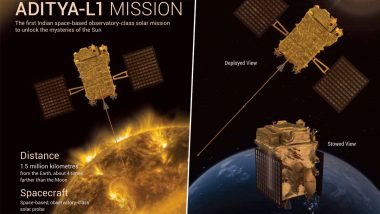Mumbai, August 28: After the success of Chandrayaan 3, the Indian Space Research Organisation (ISRO) is now on the cusp of another historic feat as it prepares to launch its pioneering space-based solar observatory spacecraft, the Aditya L1 mission on September 2. The ambitious project promises to unravel the mysteries of the Sun's behaviour and its impact on space weather, marking a significant leap forward in our understanding of our nearest star. Named after the Sun's core, the Aditya L1 mission is poised to make groundbreaking observations.
However, a misconception has arisen regarding its ultimate destination among the country's citizens. Contrary to popular belief, Aditya L1 will not embark on a direct journey to the Sun. Instead, according to ISRO, it will strategically position itself in a halo orbit around the Lagrange point 1 (L1) of the Sun-Earth system, situated approximately 1.5 million kilometres away from our planet. This strategic location at L1 will provide Aditya L1 with an unobstructed and continuous view of the Sun, devoid of hindrances posed by eclipses or occultation. Aditya L1: As ISRO Sets Date for Launch of Solar Mission, Know Objectives, Payloads and Other Details About India's First Space-Based Observatory to Study Sun.
This vantage point is pivotal for scientists aiming to scrutinise solar activities and their real-time influence on space weather. The L1 point represents a unique equilibrium in space where the gravitational forces of two massive bodies – the Sun and the Earth – exactly counterbalance the centripetal force required for a smaller object to coexist with them. This harmonious balance facilitates a spacecraft's ability to remain in a stable position with minimal energy consumption. The Solar and Heliospheric Observatory Satellite (SOHO) resides at the L1 point, consistently monitoring the Sun's dynamics. Aditya-L1 Mission Launch Date: After Chandrayaan 3 Success, ISRO to Launch First Space-Based Indian Observatory to Study Sun on September 2.
According to the India Today report, Aditya L1's journey to its designated halo orbit around the L1 point will span over 100 Earth days after its launch. The 1,500 kg satellite is equipped with seven scientific payloads, each tailored to distinct objectives. These include investigating coronal heating, solar wind acceleration, coronal magnetometry, the origin and monitoring of near-UV solar radiation, and the continuous observation of the photosphere, chromosphere, and corona. Central to the mission's objectives is an in-depth exploration of the factors influencing the formation and composition of solar wind, a phenomenon that impacts space weather.
Furthermore, the mission aims to provide crucial insights into the genesis of coronal mass ejections (CMEs) and solar flares. By combining these multifaceted observations, the Aditya L1 mission aspires to unravel the intricate dynamics of the Sun and their consequences for the interplanetary environment. ISRO underscores the mission's significance in shedding light on space weather drivers and potentially revolutionising our comprehension of the Sun's dynamics.
(The above story first appeared on LatestLY on Aug 28, 2023 04:54 PM IST. For more news and updates on politics, world, sports, entertainment and lifestyle, log on to our website latestly.com).













 Quickly
Quickly




















